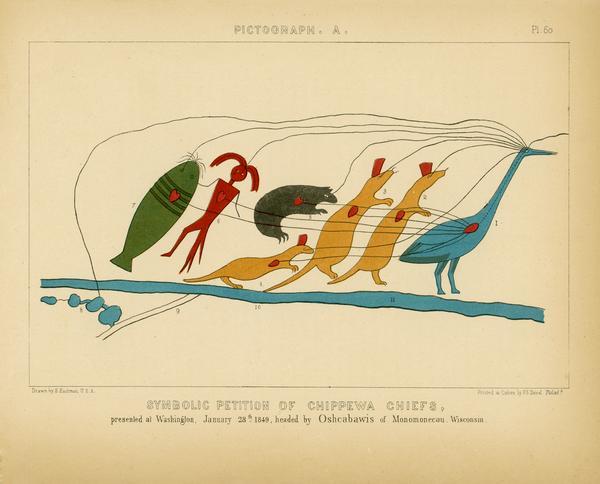Book or Pamphlet
Symbolic Petition of the Chippewa Chiefs

| This image was copied by artist Seth Eastman in 1849 and printed in Henry Rowe Schoolcraft's The History of the Indian Tribes of the United States, Historical and Statistical Information Respecting the History, Condition, and Prospects of the Indian Tribes of the United States, (Philadelphia, 1851). Schoolcraft says there (pp. 414-417) that a birch bark version was carried by Oshcabawis to Washington in 1849 when the tribe petitioned the U.S. to adjust boundaries of the 1842 LaPointe treaty. It was intended as a sort of letter of reference, depicting their authority to speak for the Lake Superior bands today called the Lac Courte Oreilles, St. Croix, Fond du Lac, Red Cliff and Bad River Ojibwe. In the decades that followed, it was also used by the Ojibwe to explain the Sandy Lake tragedy of 1850-51. Contemporary elders say that the lines from the hearts and eyes of the Catfish, Man-fish, Bear, and the three Martens to the heart and eye of the Crane signify that all the headmen shared the same views. The last line, going out from the Crane's eye, indicated that the entire group had authorized Chief Buffalo (Crane Clan) to speak to President Fillmore on their behalf. |
| Image ID: | 1871 |
|---|---|
| Creation Date: | 1851 |
| Creator Name: | Eastman, Seth |
| City: | |
| County: | |
| State: | |
| Collection Name: | Rare Books |
| Genre: | Book or Pamphlet |
| Original Format Type: | prints, fine-art |
| Original Format Number: | E77 S381 ocm06202862 |
| Original Dimensions: | 12 x 9.5 inches |
| The History of the Indian Tribes of the United States, Historical and Statistical Information Respecting the History, Condition, and Prospects of the Indian Tribes of the United States, Volume 1, by Henry R. Schoolcraft, Pictograph. A., plate 60. The plate is named, "Symbolic Petition of the Chippewa Chiefs, presented at Washington, January 28th, 1849, headed by Oshcabawis of Monomonecau, Wisconsin." |
| Signs and symbols |
| Drawing |
| Painting |
| Ojibwe people |
| Indigenous peoples of North America, Social life and customs |
| Special days |
| Animals |
| This image is issued by the Wisconsin Historical Society. Use of the image requires written permission from the staff of the Collections Division. It may not be sold or redistributed, copied or distributed as a photograph, electronic file, or any other media. The image should not be significantly altered through conventional or electronic means. Images altered beyond standard cropping and resizing require further negotiation with a staff member. The user is responsible for all issues of copyright. Please Credit: Wisconsin Historical Society. |
| Location: | Wisconsin Historical Society Archives, 4th Floor, Madison, Wisconsin |
|---|
